Tectonic Evolution and Structural Control of Dike-Hosted Orogenic Gold Deposits in the Yana–Kolyma Collision Orogen (Eastern Siberia): Insights from the Eastern Margin of the Siberian Craton
Abstract
1. Introduction
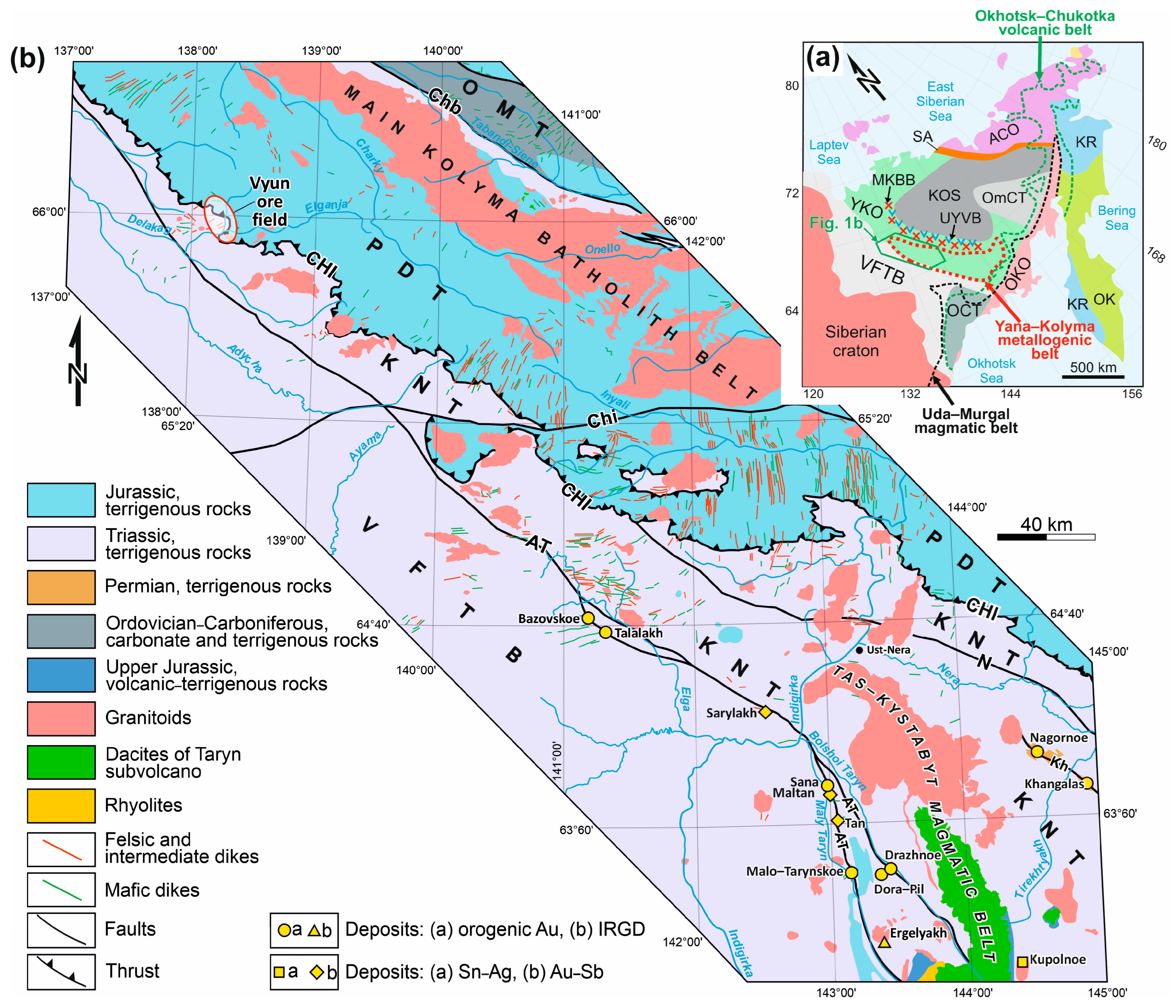
2. Regional Geology, Magmatism, and Metallogenic Setting
2.1. Regional Geology
2.2. Magmatism
2.2.1. Main Kolyma Batholith Belt
2.2.2. Uyandina–Yasachnaya Volcanic Belt
2.2.3. Transverse Magmatic Series
2.3. Regional Metallogeny
2.3.1. Orogenic Metallogeny
2.3.2. Post-Orogenic Metallogeny
2.4. District Geology and Mineralization
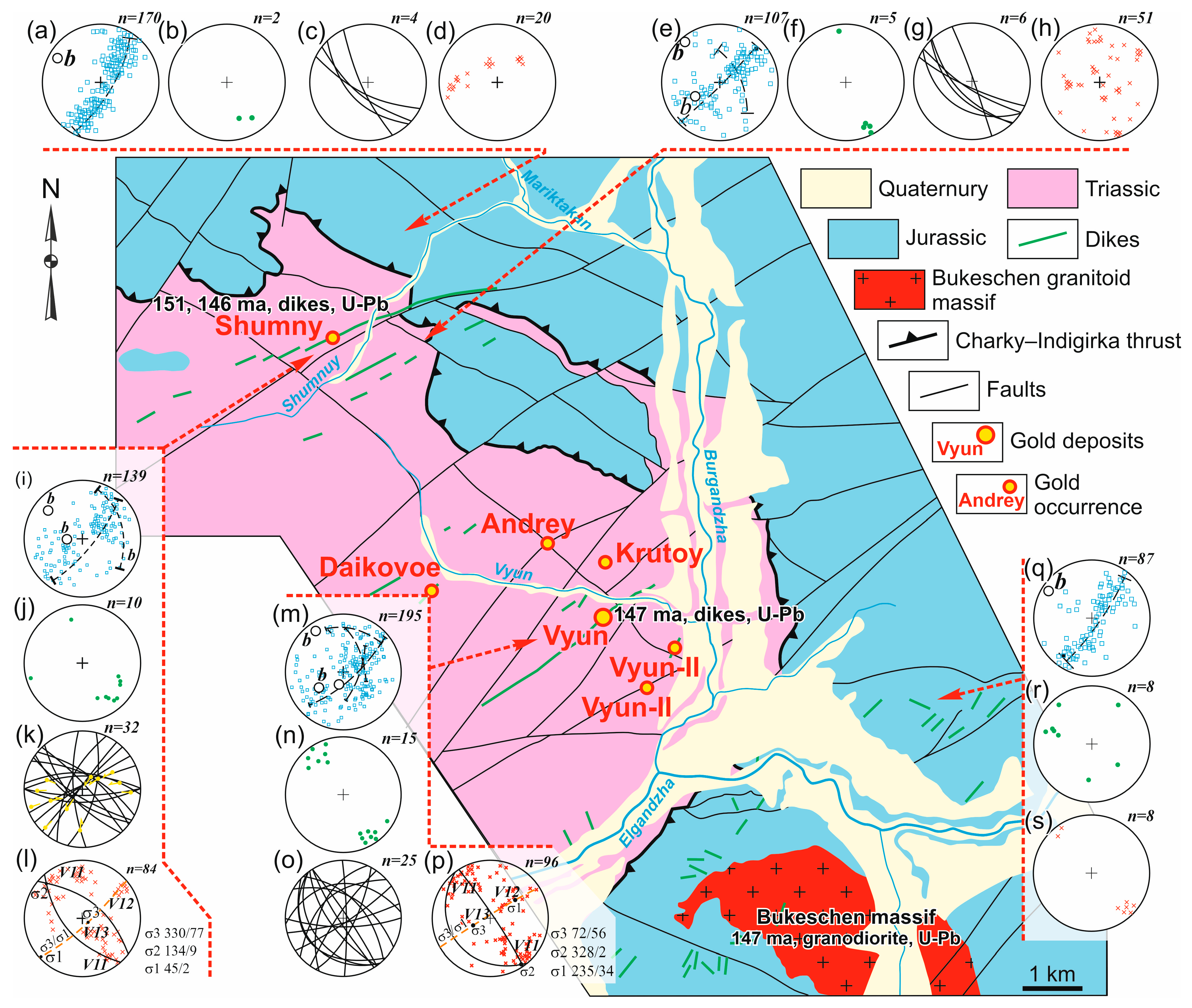
3. Materials and Methods
4. Results
4.1. Structural Analysis of Two Au Districts in the Parautochthon of the Charky–Indigirka Thrust
4.1.1. Vyun Gold Deposit
4.1.2. The Shumny Area
4.2. Structural Analysis of the Allochthon of the Charky–Indigirka Thrust
5. Discussion
5.1. Style of Deformation, Space–Time Distribution, and Structural Control
5.1.1. Pre-Mineralization
5.1.2. Mineralization
5.1.3. Post-Mineralization
5.2. Correlation Mineralization and Regional Deformation
6. Conclusions
Author Contributions
Funding
Data Availability Statement
Acknowledgments
Conflicts of Interest
References
- Gamyanin, G.N. Mineralogical and Genetic Aspects of Gold Mineralization of Verkhoyansk-Kolyma Mesozoids; Nauka: Moscow, Russia, 2001; 222p. (In Russian) [Google Scholar]
- Goryachev, N.A.; Pirajno, F. Gold deposits and gold metallogeny of Far East Russia. Ore Geol. Rev. 2014, 59, 123–151. [Google Scholar] [CrossRef]
- Goldfarb, R.J.; Taylor, R.; Collins, G.; Goryachev, N.A.; Orlandini, O.F. Phanerozoic continental growth and gold metallogeny of Asia. Gondwana Res. 2014, 25, 49–102. [Google Scholar] [CrossRef]
- Voroshin, S.V.; Tyukova, E.E.; Newberry, R.J.; Layer, P.W. Orogenic gold and rare metal deposits of the Upper Kolyma District, Northeastern Russia: Relation to igneous rocks, timing, and metal assemblages. Ore Geol. Rev. 2014, 62, 1–24. [Google Scholar] [CrossRef]
- Fridovsky, V.Y. Structural control of orogenic gold deposits of the Verkhoyansk-Kolyma folded region, northeast Russia. Ore Geol. Rev. 2018, 103, 38–55. [Google Scholar] [CrossRef]
- Fridovsky, V.Y.; Polufuntikova, L.I.; Kryazhev, S.G.; Kudrin, M.V.; Anisimova, G.S. Geology, fluid inclusions, mineral and (S-O) isotope chemistry of the Badran orogenic Au deposit, Yana-Kolyma belt, Eastern Siberia: Implications for ore genesis. Front. Earth Sci. 2024, 12, 1340112. [Google Scholar] [CrossRef]
- Kudrin, M.V.; Fridovsky, V.Y.; Polufuntikova, L.I.; Kryazhev, S.G.; Kolova, E.E.; Tarasova, Y.A. The Khangalas Orogenic Au Deposit, Yana–Kolyma Metallogenic Belt (Northeast Russia): Structure, Ore Mineral and Isotopic (O, S, Re, Os, Pb, Ar, and He) Composition, Fluid Regime, and Formation Conditions. Geol. Ore Depos. 2024, 66, 484–511. [Google Scholar] [CrossRef]
- Gamyanin, G.N.; Goryachev, N.A.; Bakharev, A.G.; Kolesnichenko, P.P.; Zaitsev, A.I.; Diman, E.N.; Berdnikov, N.V. Conditions of Initiation and Evolution of Granitoid Gold–Magmatic Systems in Mesozoides of Northeast Asia; SVKNII DVO RAN: Magadan, Russia, 2003. (In Russian) [Google Scholar]
- Zaitsev, A.I.; Fridovsky, V.Y.; Kudrin, M.V. Granitoids of the Ergelyakh intrusion-related gold–bismuth deposit (Kular-Nera Slate Belt, Northeast Russia): Petrology, physicochemical parameters of formation, and ore potential. Minerals 2019, 9, 297. [Google Scholar] [CrossRef]
- Vikent’eva, O.V.; Prokofiev, V.Y.; Gamyanin, G.N.; Bortnikov, N.S.; Goryachev, N.A. Intrusion-related gold-bismuth deposits of North-East Russia: PTX parameters and sources of hydrothermal fluids. Ore Geol. Rev. 2018, 102, 240–259. [Google Scholar] [CrossRef]
- Hart, C.J.R.; McCoy, D.; Goldfarb, R.J.; Smith, M.; Roberts, P.; Hulstein, R.; Blake, A.A.; Bundtzen, T.K. Geology, exploration and discovery in the Tintina gold province, Alaska and Yukon. Soc. Econ. Geol. Spec. Publ. 2002, 9, 241–274. [Google Scholar]
- Ashley, P.M.; Craw, D. Structural controls on hydrothermal alteration and gold–antimony mineralisation in the Hillgrove area, NSW, Australia. Miner. Depos. 2004, 39, 223–239. [Google Scholar] [CrossRef]
- Jowitt, S.M.; Keays, R.R.; Jackson, P.G.; Hoggart, C.R.; Green, A.H. Mineralogical and geochemical controls on the formation of the Woods Point dike swarm, Victoria, Australia: Evidence from the Morning Star dike and implications for sourcing of Au within orogenic gold systems. Econ. Geol. 2012, 107, 251–273. [Google Scholar] [CrossRef]
- Volkov, A.V.; Prokofiev, V.Y.; Sidorov, A.A.; Goryachev, N.A. Gold deposits in the dikes of the Yana-Kolyma belt. Geol. Ore Depos. 2008, 50, 311–337. [Google Scholar] [CrossRef]
- Anisimova, G.S.; Protopopov, R.I. Geological structure and ore composition of the Vyun gold-quartz deposit, Eastern Yakutia. Ores Met. 2009, 5, 59–69. [Google Scholar]
- Pachersky, N.V.; Kryazhev, S.G.; Naumov, E.A.; Desyatova, D.Y.; Dvurechenskaya, S.S.; Samoilenko, M.V. New data on the reduced intrusion-related Au mineralization of Sentral Lolyma gold region: Age, formation conditions, composition, ore-controlling factors. Ores Met. 2021, 2, 68–89. (In Russian) [Google Scholar] [CrossRef]
- Fridovsky, V.Y.; Yakovleva, K.Y.; Vernikovskaya, A.E.; Vernikovsky, V.A.; Matushkin, N.Y.; Kadilnikov, P.I.; Rodionov, N.V. Geodynamic emplacement setting of Late Jurassic dikes of the Yana–Kolyma Gold Belt, NE folded framing of the Siberian Craton: Geochemical, petrologic, and U–Pb zircon data. Minerals 2020, 10, 1000. [Google Scholar] [CrossRef]
- Fridovsky, V.Y.; Vernikovskaya, A.E.; Yakovleva, K.Y.; Rodionov, N.V.; Travin, A.V.; Matushkin, N.Y.; Kadilnikov, P.I. Geodynamic formation conditions and age of granitoids from small intrusions in the west of the Yana–Kolyma gold belt (Northeast Asia). Russ. Geol. Geophys. 2022, 63, 483–502. [Google Scholar] [CrossRef]
- Goldfarb, R.J.; Baker, T.; Dube, B.; Groves, D.I.; Hart, C.J.R.; Gosselin, P. Distribution, character, and genesis of gold deposits in metamorphic terranes. In Economic Geology One Hundredth Anniversary Volume; Hedenquist, J.W., Thompson, J.F.H., Goldfarb, R.J., Richards, J.P., Eds.; Society of Economic Geologists: Littleton, CO, USA, 2005; pp. 407–450. [Google Scholar] [CrossRef]
- Goldfarb, R.; Groves, D. Orogenic gold: Common or evolving fluid and metal sources through time. Lithos 2015, 233, 2–26. [Google Scholar] [CrossRef]
- Groves, D.I.; Santosh, M.; Deng, J.; Wang, Q.; Yang, L.; Zhang, L. A holistic model for the origin of orogenic gold deposits and its implications for exploration. Miner. Depos. 2018, 55, 275–292. [Google Scholar] [CrossRef]
- Deng, J.; Wang, Q.F.; Santosh, M.; Liu, X.F.; Liang, Y.Y.; Zhao, R.; Yang, L. Remobilization of metasomatized mantle lithosphere: A new model for the Jiaodong gold province, eastern China. Min. Dep. 2020, 55, 257–274. [Google Scholar] [CrossRef]
- Yang, L.; Wang, Q.; Groves, D.I.; Lu, S.; Li, H.; Wang, P.; Deng, J. Multiple orogenic gold mineralization events in a collisional orogen: Insights from an extruded terrane along the southeastern margin of the Tibetan Plateau. J. Struct. Geol. 2021, 147, 104333. [Google Scholar] [CrossRef]
- Zhao, H.; Wang, Q.; Groves, D.I.; Santosh, M.; Zhang, J.; Fan, T. Genesis of orogenic gold systems in the Daduhe belt: Evidence of long-lived fertile mantle lithosphere as a source of diverse metallogeny on the western margin of the Yangtze Craton, China. Ore Geol. Rev. 2022, 145, 104861. [Google Scholar] [CrossRef]
- Parfenov, L.M.; Kuz’min, M.I. Tectonics, Geodynamics and Metallogeny of the Territory of the Republic of Sakha (Yakutia); Nauka/Interperiodika: Moscow, Russia, 2001; p. 571. (In Russian) [Google Scholar]
- Khanchuk, A.I. Geodynamics, Magmatism, and Metallogeny of Eastern Russia; Dal’nauka: Vladivostok, Russia, 2006; p. 527. (In Russian) [Google Scholar]
- Nokleberg, W.J.; Parfenov, L.M.; Norton, I.O.; Khanchuk, A.I.; Stone, D.B.; Scholl, D.W.; Fujita, K. Phanerozoic Tectonic Evolution of the Circum-North Pacific; US Geological Survey, Professional Papers: Denver, CO, USA, 2001; Volume 1626, p. 123. [Google Scholar]
- Sokolov, S.D.; Tuchkova, M.I.; Ledneva, G.V.; Luchitskaya, M.V.; Ganelin, A.V.; Vatrushkina, E.V.; Moiseev, A.V. Tectonic position of the South Anyui Suture. Geotectonics 2021, 5, 51–72. [Google Scholar] [CrossRef]
- Fridovsky, V.Y.; Kudrin, M.V.; Polufuntikova, L.I.; Goryachev, N.A. Ore-controlling thrust faults at the Bazovskoe gold-ore deposit (Eastern Yakutia). Dokl. Earth Sci. 2017, 474, 617–619. [Google Scholar] [CrossRef]
- Fridovsky, V.Y.; Goryachev, N.A.; Krymsky, R.S.; Kudrin, M.V.; Belyatsky, B.V.; Sergeev, S.A. The Age of gold mineralization in the Yana–Kolyma metallogenic belt, Northeastern Russia: First data of Re–Os isotope geochronology of native gold. Russ. J. Pac. Geol. 2021, 15, 293–306. [Google Scholar] [CrossRef]
- Zonenshain, L.P.; Kuzmin, M.I.; Natapov, L.M. Tectonics of Lithospheric Plates of the USSR Territory; Nedra: Moscow, Russia, 1990; Volume 1, 327p. [Google Scholar]
- Arkhipov, Y.V.; Volkodav, I.G.; Kamaletdinov, V.A.; Yan-Zhin-Shin, V.A. Thrusts of the western part of the Verkhoyansk-Chukotka folded region. Geotectonics 1981, 2, 81–98. [Google Scholar]
- Konstantinovsky, A.A. Structure and geodynamics of the Verkhoyansk Fold-Thrust Belt. Geotectonics 2007, 41, 337–354. [Google Scholar] [CrossRef]
- Parfenov, L.M.; Badarch, G.; Berzin, N.A.; Khanchuk, A.I.; Kuzmin, M.I.; Nokleberg, W.J.; Prokopiev, A.V.; Ogasawara, M.; Yan, H. Summary of Northeast Asia geodynamics and tectonics. Stephan Mueller Spec. Publ. Ser. 2009, 4, 11–33. [Google Scholar] [CrossRef]
- Tsygankov, A.A.; Burmakina, G.N.; Khubanov, V.B. Sources of granitoid magmas in the southern part of the Main Batholith Belt (Northeast Asia): New geochemical and Sm-Nd isotope data. In Proceedings of the Geology and mineral resources of the North-East of Russia, Yakutsk, Russia, 30 March 2022. [Google Scholar]
- Protopopov, G.K.; Trushchelev, A.M.; Kuznetsov, Y.V. State Geological Map of the Russian Federation at a Scale of 1:1000000. Third Generation. Verkhoyansk-Kolyma Series. Sheet Q-54—Ust-Nera. Explanatory Note; Publishing House VSEGEI: St. Petersburg, Russia, 2019; 2019845p. [Google Scholar]
- Akinin, V.V.; Prokopiev, A.V.; Toro, J.; Miller, E.L.; Wooden, J.; Goryachev, N.A.; Alshevsky, A.V.; Bakharev, A.G.; Trunilina, V.A. U–PB SHRIMP ages of granitoids from the Main batholith belt (North East Asia). Dokl. Earth Sci. 2009, 426, 216–221. [Google Scholar] [CrossRef]
- Gertseva, M.V.; Luchitskaya, M.V.; Sysoev, I.V.; Sokolov, S.D. Stages of formation of the main batholith belt in the Northeast of Russia: U–Th–Pb SIMS and Ar–Ar geochronological data. Dokl. Akad. Nauk. 2021, 499, 5–10. [Google Scholar] [CrossRef]
- Layer, P.W.; Newberry, R.; Fujita, K.; Parfenov, L.; Trunilina, V.; Bakharev, A. Tectonic setting of the plutonic belts of Yakutia, northeast Russia, based on 40Ar/39Ar geochronology and trace element geochemistry. Geology 2001, 29, 167–170. [Google Scholar] [CrossRef]
- Shkodzinsky, V.S.; Nedosekin, Y.D.; Surnin, A.A. Petrology of Late Mesozoic Igneous Rocks of Eastern Yakutia; Nauka: Novosibirsk, Russia, 1992; 237p. [Google Scholar]
- Trunilina, V.A.; Roev, S.P.; Orlov, Y.S.; Oksman, V.S. Magmatism in Various Geodynamic Settings (the Junction Zone of the Verkhoyansk Margin of the Siberian Continent and the Kolyma-Omolon Microcontinent); YANTS SB RAS: Yakutsk, Russia, 1999; 151p. [Google Scholar]
- Trunilina, V.A.; Orlov, Y.S.; Roev, S.P. Magmatic associations of the Uyandino-Yasachnensky volcano-plutonic belt and its geodynamic nature. Dom. Geol. 2004, 5, 53–56. [Google Scholar]
- Toro, J.; Miller, E.L.; Prokopiev, A.V.; Zhang, X.; Veselovskiy, R. Mesozoic orogens of the Arctic from Novaya Zemlya to Alaska. J. Geol. Soc. 2016, 173, 989–1006. [Google Scholar] [CrossRef]
- Ganelin, A.V.; Luchitskaya, M.V.; Maskaev, M.V. U–Th–Pb (SIMS) Age and formation conditions of volcanic rocks of the Indigir section of the Uyandi-Yasachne volcanic belt (Northeast Asia). Rep. Russ. Acad. Sci. Earth Sci. 2021, 496, 11–16. [Google Scholar] [CrossRef]
- Stavsky, A.P.; Gedko, M.I.; Danilov, V.G. Uyandino-Yasachaya Island Arc: Geological Mapping of Volcano-Plutonic Belts; Roskomnedra, Geokart, MANPO: Moscow, Russia, 1994; pp. 265–296. [Google Scholar]
- Gedko, M.I. Uyandino-Yasachenskaya Late Jurassic Island Arc (North-East of Russia). Geotectonics 1988, 3, 153–165. [Google Scholar]
- Nokleberg, W.J.; Bundtzen, T.K.; Eremin, R.A.; Ratkin, V.V.; Dawson, K.M.; Shpikerman, V.I.; Goryachev, N.A.; Byalobzhesky, S.G.; Frolov, Y.F.; Khanchuk, A.I.; et al. Metallogenesis and Tectonics of the Russian Far East, Alaska, and the Canadian Cordillera; USGS Professional Paper: Reston, VA, USA, 2005; Volume 1697. [Google Scholar]
- Akinin, V.V.; Alshevsky, A.V.; Polzunenkov, G.O.; Sergeev, S.A.; Sidorov, V.A. The age of Natalka orogenic gold deposit (U-Pb, 40Ar/39Ar, Re-Os constrain). Russ. J. Pac. Geol. 2023, 17, 570–585. [Google Scholar] [CrossRef]
- Obolensky, A.A.; Gushchina, L.V.; Anisimova, G.S.; Serkebaeva, E.S.; Tomilenko, A.A.; Gibsher, N.A. Physicochemical modeling of mineral formation processes at the Badran gold deposit (Yakutia). Russ. Geol. Geophys. 2011, 52, 290–306. [Google Scholar] [CrossRef]
- Goryachev, N.A.; Goryachev, I.N.; Sotskaya, O.T.; Mikhalitsyna, T.I. The early cretaceous mineralization of the northern Priokhotye (Magadan region, Russia). Russ. J. of Pac. Geol. 2023, 42, 118–130. (In Russian) [Google Scholar] [CrossRef]
- Fridovsky, V.Y.; Polufuntikova, L.I.; Kudrin, M.V. Origin of disseminated gold-sulfide mineralization from proximal alteration in orogenic gold deposits in the central sector of the Yana–Kolyma metallogenic belt, NE Russia. Minerals 2023, 13, 394. [Google Scholar] [CrossRef]
- Goldfarb, R.J.; Groves, D.I.; Gardoll, S. Orogenic gold and geologic time: A synthesis. Ore Geol. Rev. 2001, 18, 1–75. [Google Scholar] [CrossRef]
- Kudrin, M.V.; Fridovsky, V.Y.; Polufuntikova, L.I.; Kryuchkova, L.Y. Disseminated Gold–Sulfide Mineralization in Metasomatites of the Khangalas Deposit, Yana–Kolyma Metallogenic Belt (Northeast Russia): Analysis of the Texture, Geochemistry, and S Isotopic Composition of Pyrite and Arsenopyrite. Minerals 2021, 11, 403. [Google Scholar] [CrossRef]
- Gzovsky, M.V. Principles of Tectonophysics; Nauka: Moscow, Russia, 1975; 536p. (In Russian) [Google Scholar]
- Sherman, S.I.; Dneprovsky, Y.I. Stress Fields in the Earth’s Crust and Geological-Structural Methods of their Study; Nauka: Novosibirsk, Russia, 1989; 157p. [Google Scholar]
- Ramsay, J.G.; Huber, M.I. Modern Structural Geology, Folds and Fractures; Academic Press: London, UK, 1987; pp. 309–700. [Google Scholar]
- Price, N.J.; Cosgrove, J.W. Analysis of Geological Structures. Cambridge University Press: Cambridge, UK, 1990. [Google Scholar]
- Fossen, H. Structural Geology; Cambridge University Press: Cambridge, UK, 2010; p. 463. [Google Scholar]
- Fossen, H.; Cavalcante, G.C.G.; Pinheiro, R.V.L.; Archanjo, C.J. Deformation–progressive or multiphase? J. Struct. Geol. 2019, 125, 82–99. [Google Scholar] [CrossRef]
- Fridovsky, V.Y. Analysis of deformation structures of the Elga ore cluster (Eastern Yakutia). Domest. Geol. 2010, 4, 39–45. [Google Scholar]
- Fridovsky, V.Y.; Gamyanin, G.N.; Polufuntikova, L.I. Dora-Pil ore field: Structure, mineralogy, and geochemistry of mineral formation environment. Ores Met. 2012, 5, 7–21. [Google Scholar]
- Fridovsky, V.Y.; Gamyanin, G.N.; Polufuntikova, L.I. The Sana Au–quartz deposit within the Taryn ore cluster. Razved. Okhrana Nedr 2013, 2, 3–7. (In Russian) [Google Scholar]
- Bortnikov, N.S.; Gamyanin, G.N.; Vikent’eva, O.V.; Prokofiev, V.Y.; Prokopyev, A.V. Gold-antimony deposits Sarylakh and Sentachan (Sakha-Yakutia): An example of the combination of mesothermal gold-quartz and epithermal stibnite ores. Geol. of Ore Depos. 2010, 52, 381–417. [Google Scholar] [CrossRef]
- Pavlovskaia, E.A.; Khudoley, A.K.; Ruh, J.B.; Moskalenko, A.N.; Guillong, M.; Malyshev, S.V. Tectonic evolution of the northern Verkhoyansk fold-and-thrust belt: Insights from palaeostress analysis and U–Pb calcite dating. Geol. Mag. 2022, 159, 2132–2156. [Google Scholar] [CrossRef]
- Akinin, V.V.; Miller, E.L.; Toro, J.; Prokopiev, A.V.; Gottlie, E.S.; Pearcey, S.; Polzunenkov, G.O.; Trunilina, V.A. Episodicity and the dance of late Mesozoic magmatism and deformation along the northern circum-Pacific margin: North-eastern Russia to the Cordillera. Earth-Sci. Rev. 2020, 208, 103272. [Google Scholar] [CrossRef]
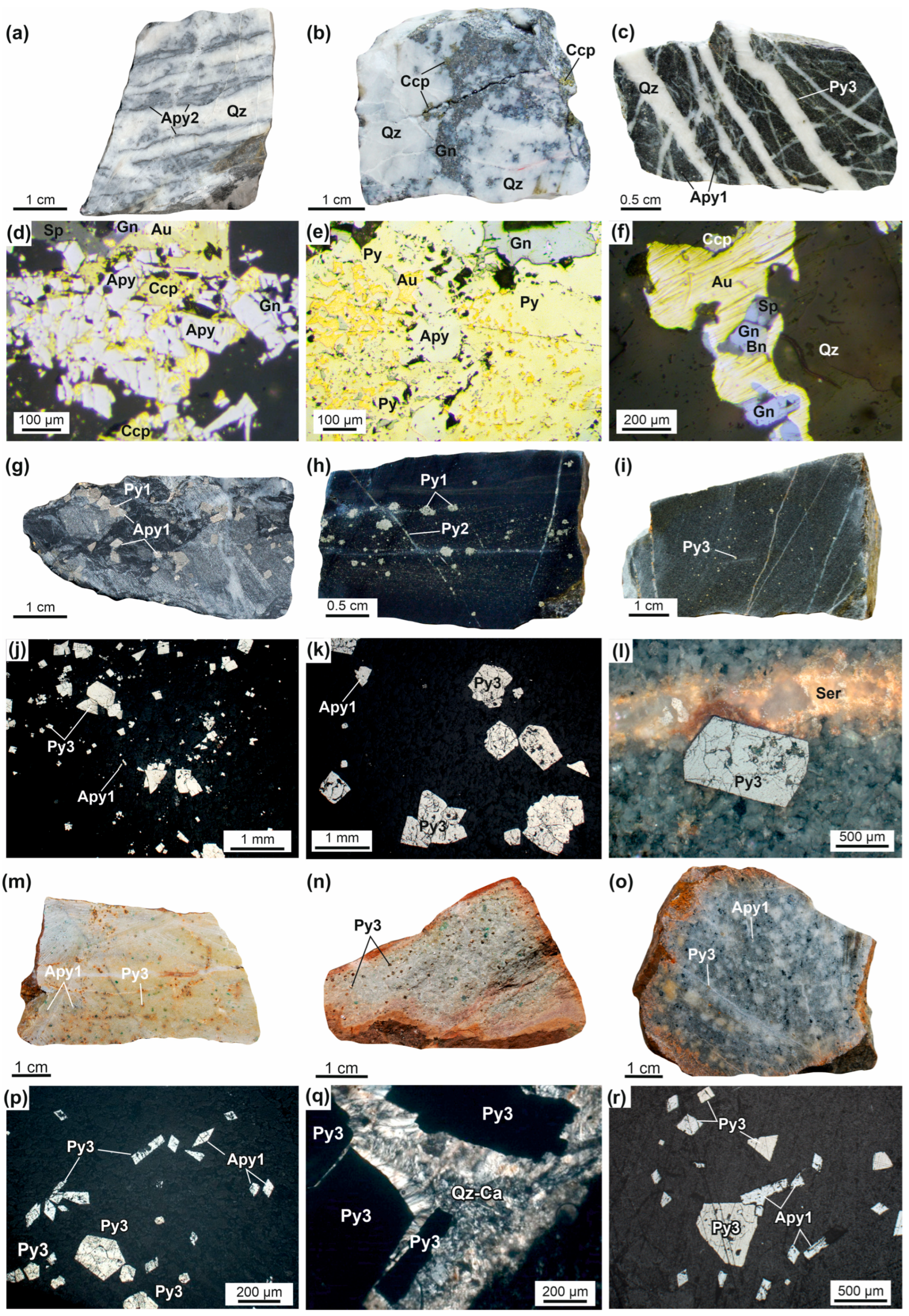
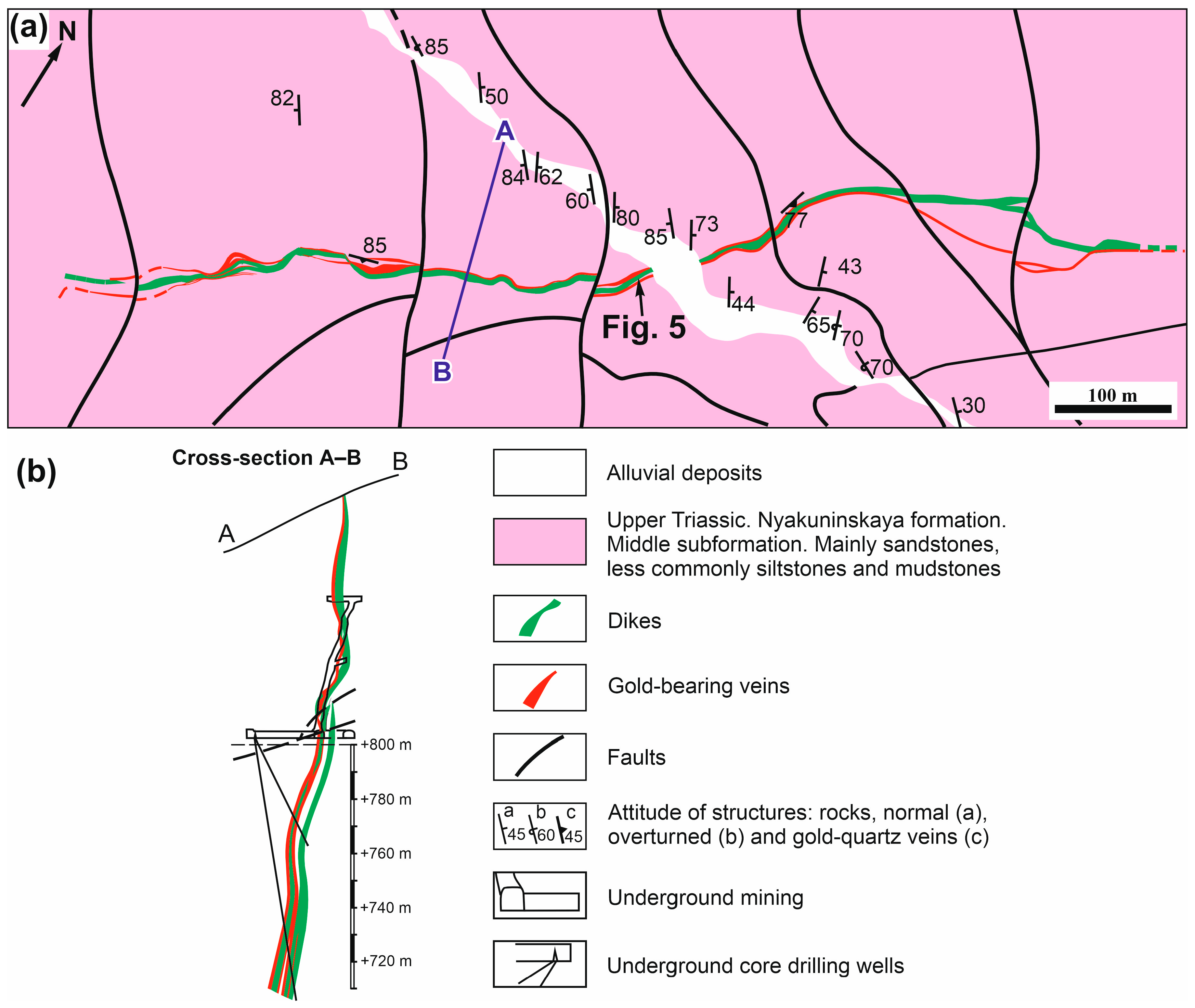
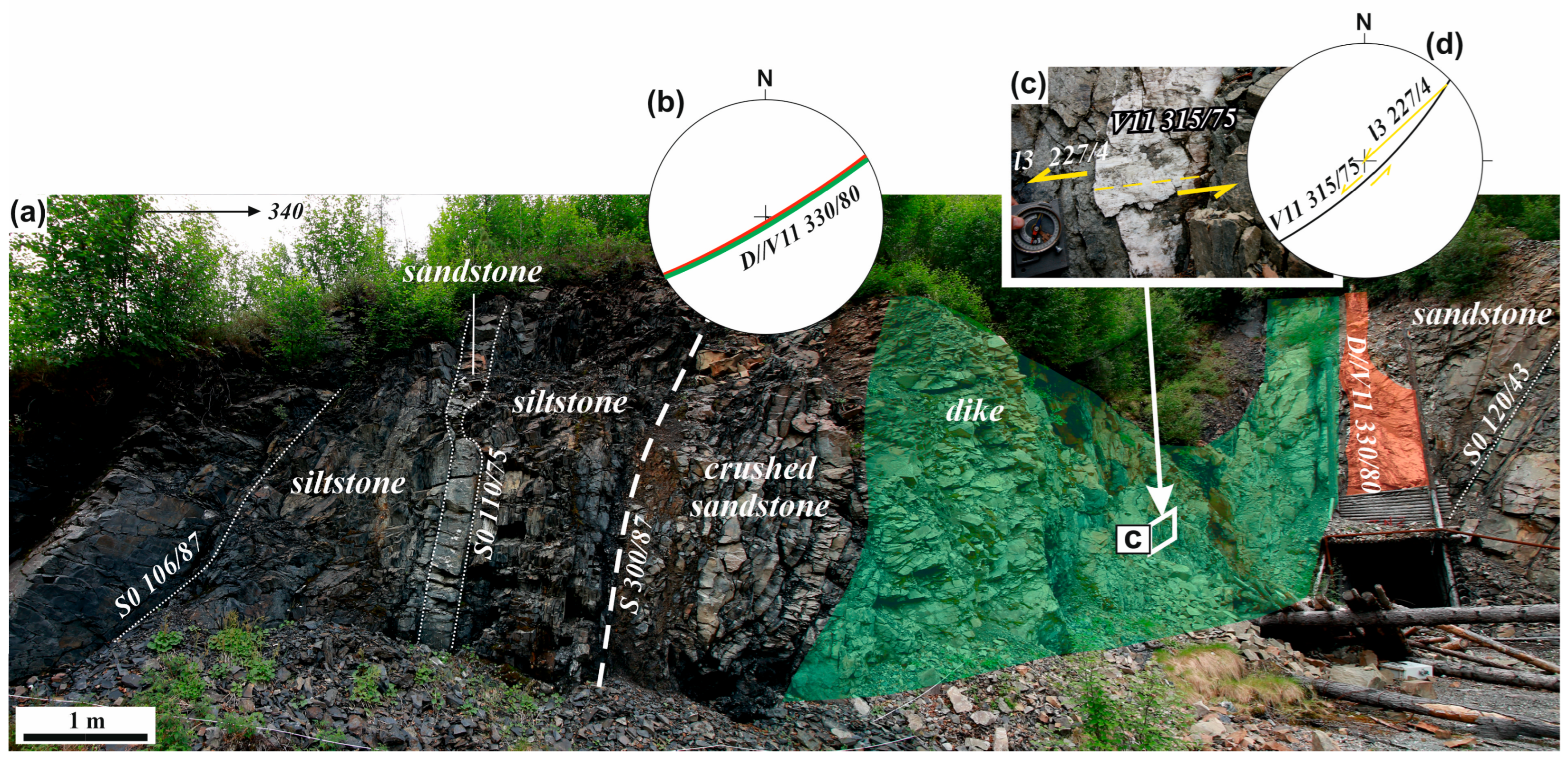
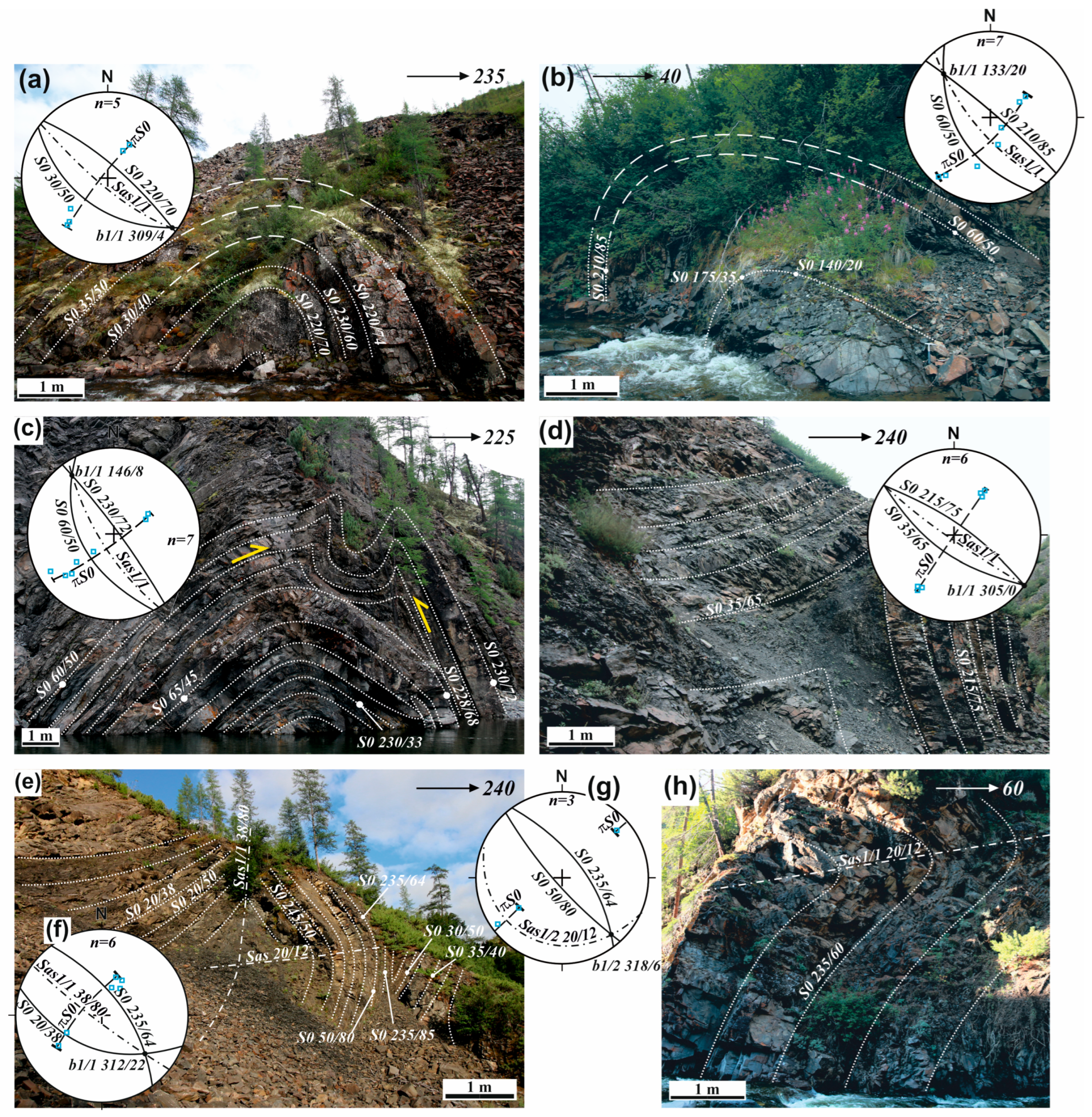

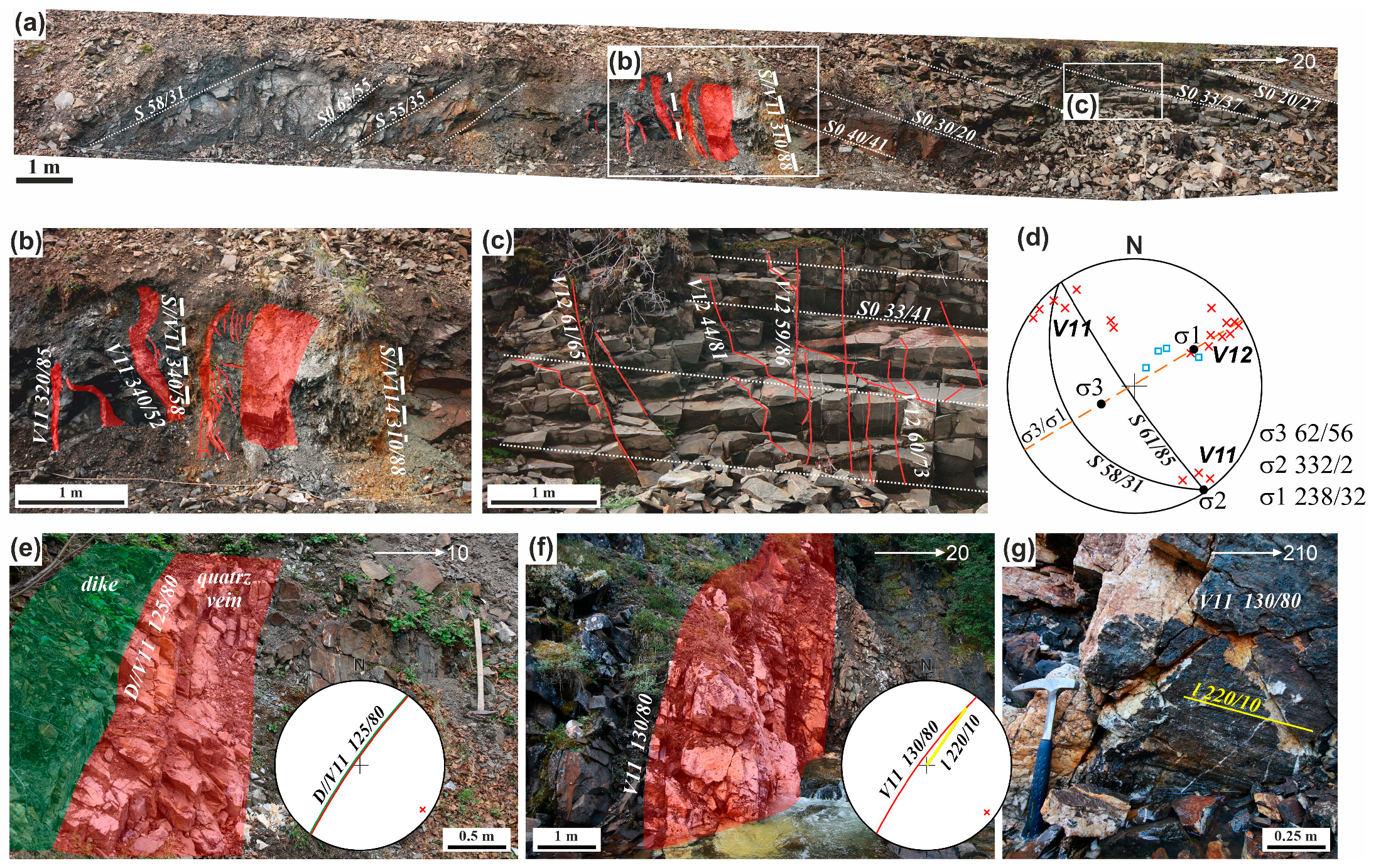
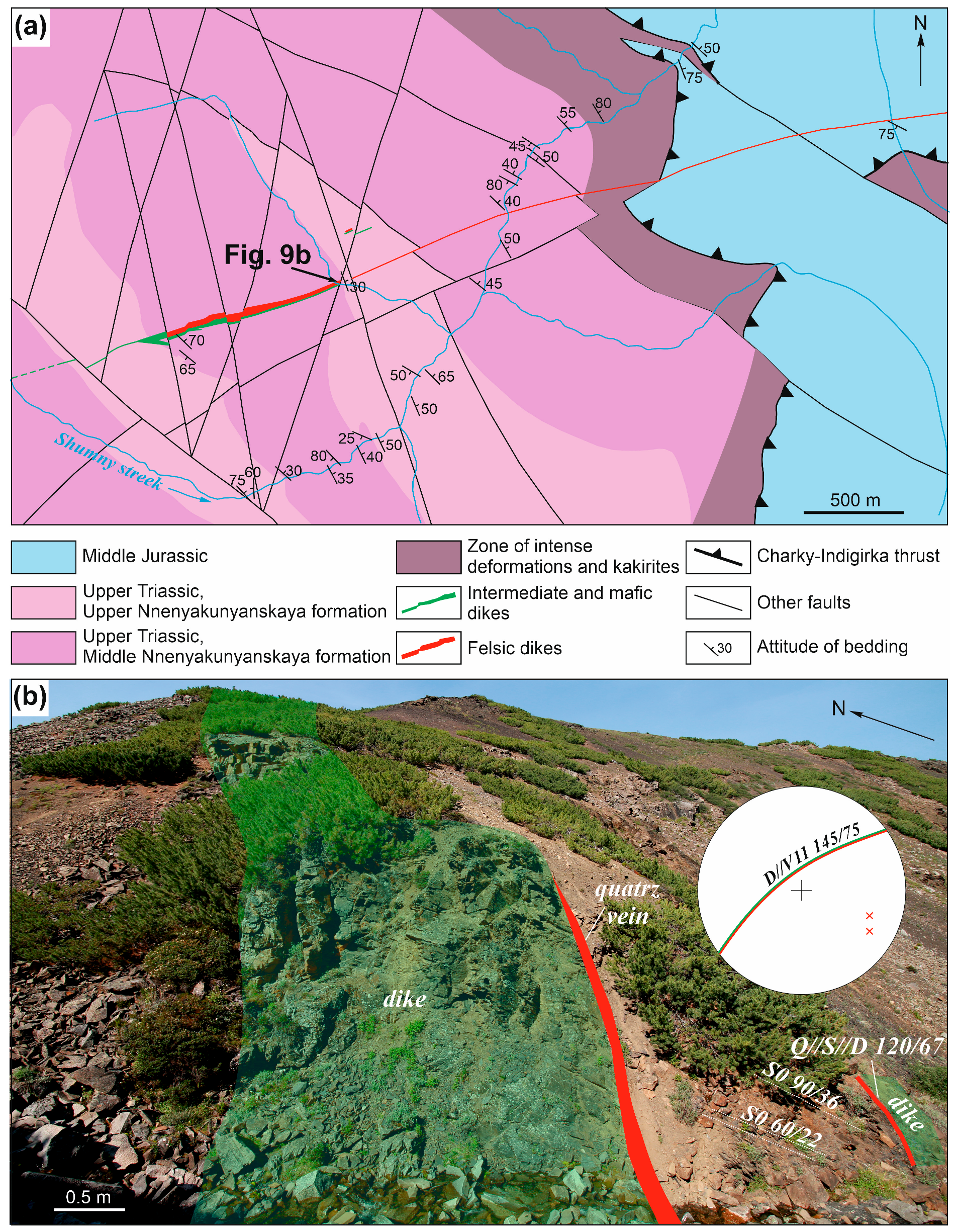

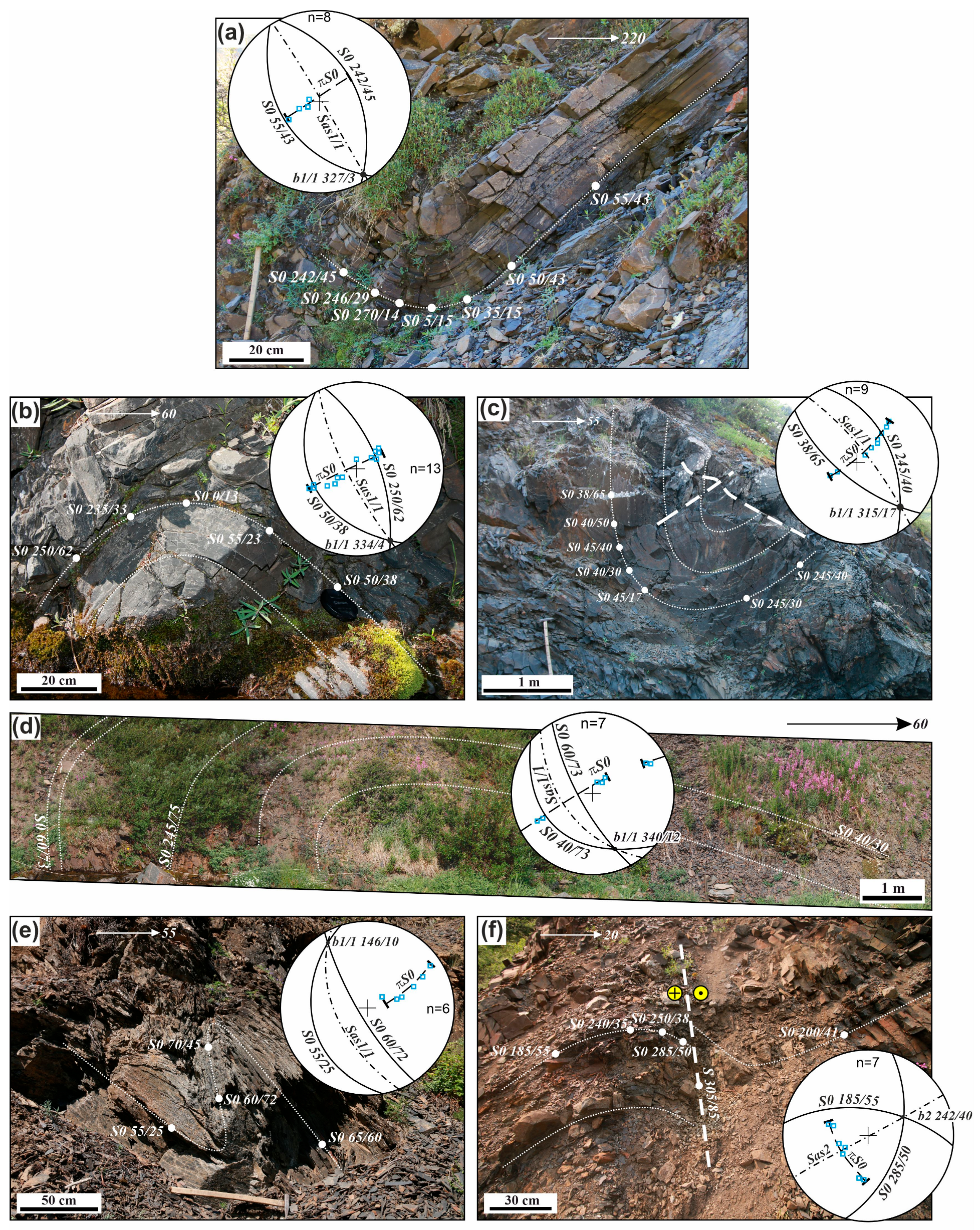

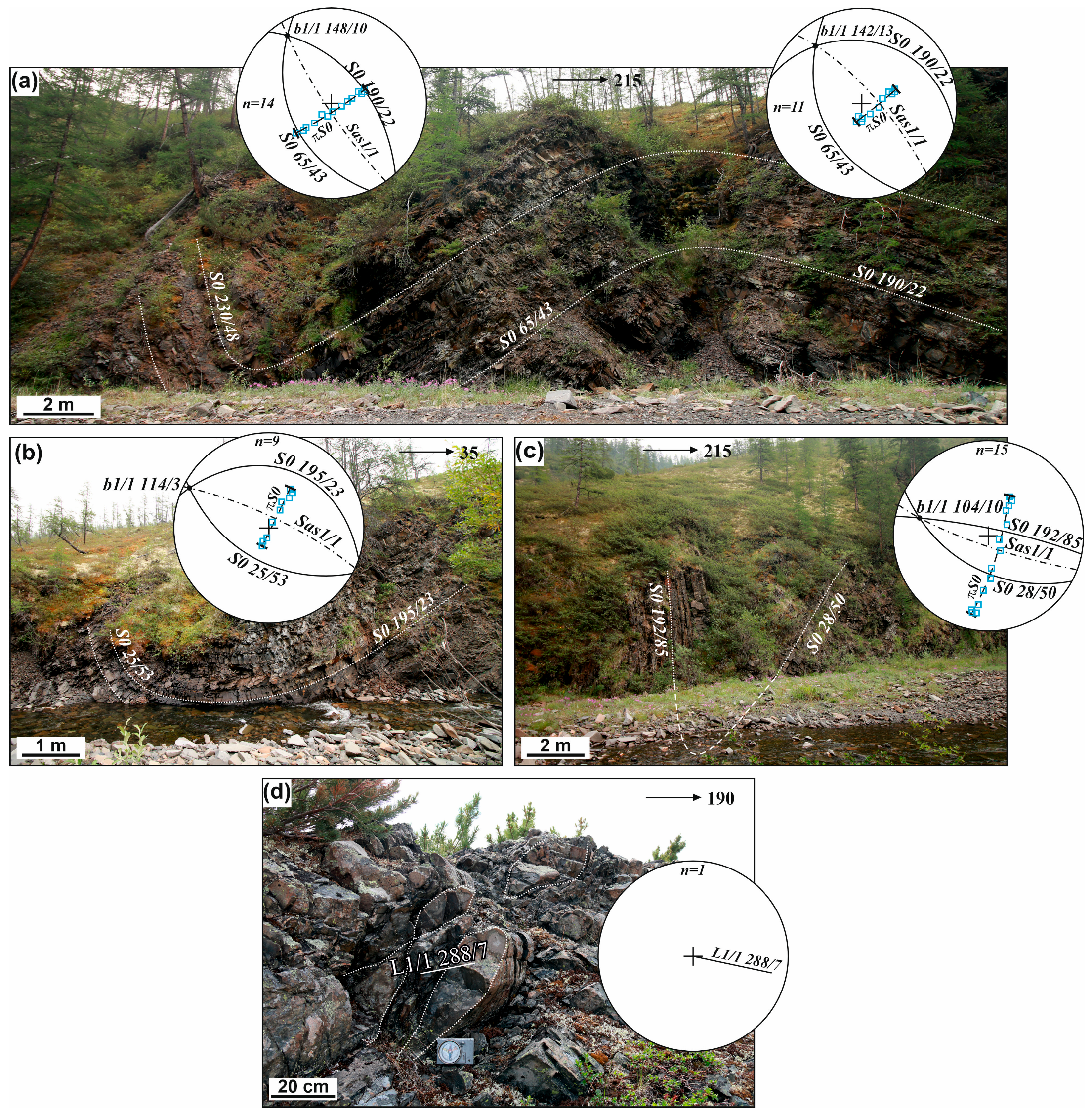
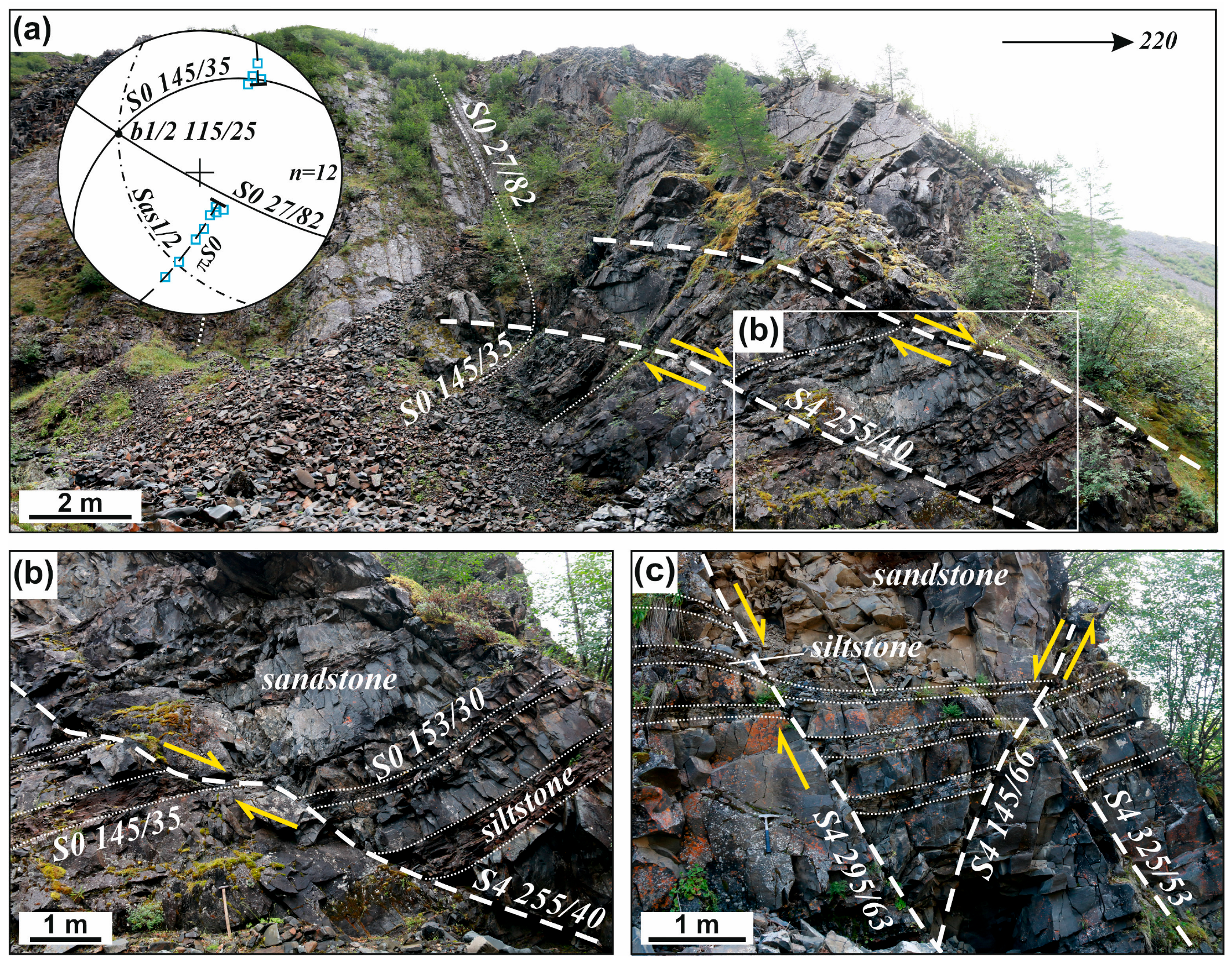
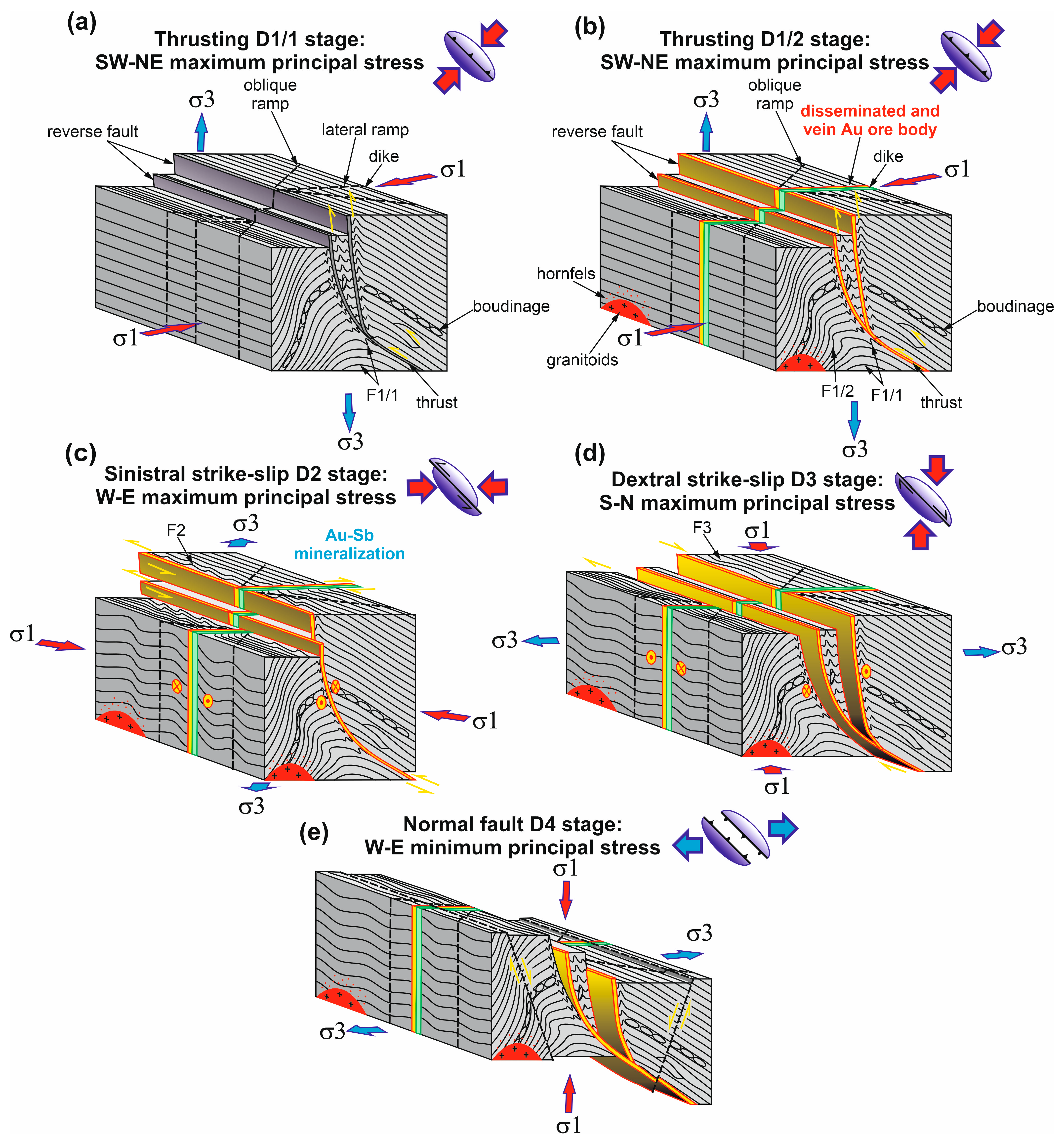
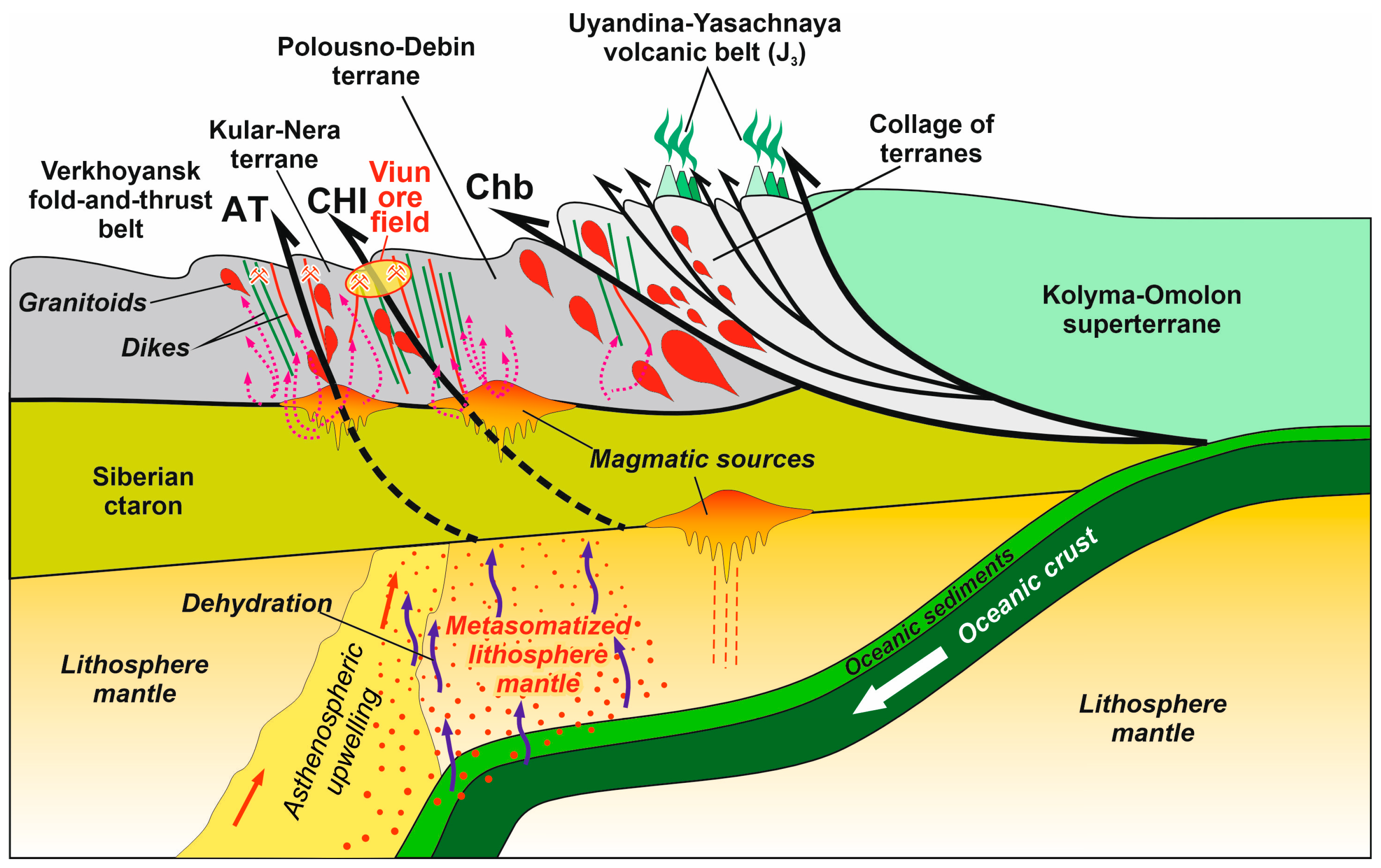
| Features | Deformation Events | |||
|---|---|---|---|---|
| D1 | D2 | D3 | D4 | |
| Structures | NW-SE folds (F1/1) with a steep axial surface Sas1/1 and b1/1 dipping 0° to 10°; S1: interlayer decollements, intrastratal ramps, NW thrusts, transverse and oblique ramps, cleavage of the fault, boudinage (L1/1); slickenlines downdip the rocks (l1); N-W folds F1/2 b with gently dipping axial surface Sas1/2 and b1/2 dipping 0° to 10° | S-type N-S, NW-SE, NE-SW folds (F2) with b2 dipping 40° to 80°; S2: NW-SE sinistral strike-slip fault, horizontal slickenlines (l2) | Z-type E-W folds (F3) with b3 dipping 40° to 80°; NW-SE dextral strike-slip fault, horizontal slickenlines (l3), boudinage (L3) | Low-amplitude NE and NNW normal faults S4, slickenlines downdip the faults |
| Kinematics of NW faults | Thrust | Sinistral strike-slip fault | Dextral strike-slip fault | Normal fault |
| Mineralization | Au Ore veins and disseminated refractory ores | Au-Sb Ore veins | ||
| Metamorphism | Greenschist metamorphism of the wall rock | |||
| Magmatism, age | Pre-ore magmatism: mafic, intermediate, and felsic dikes, strike NE-SW 151–145 Ma; granitoids, 144.5 Ma | |||
| Orientation maximum principal stress | NE-SW | E-W | N-S | W-E |
| Graphical model |  |  |  |  |
Disclaimer/Publisher’s Note: The statements, opinions and data contained in all publications are solely those of the individual author(s) and contributor(s) and not of MDPI and/or the editor(s). MDPI and/or the editor(s) disclaim responsibility for any injury to people or property resulting from any ideas, methods, instructions or products referred to in the content. |
© 2025 by the authors. Licensee MDPI, Basel, Switzerland. This article is an open access article distributed under the terms and conditions of the Creative Commons Attribution (CC BY) license (https://creativecommons.org/licenses/by/4.0/).
Share and Cite
Fridovsky, V.Y.; Kudrin, M.V. Tectonic Evolution and Structural Control of Dike-Hosted Orogenic Gold Deposits in the Yana–Kolyma Collision Orogen (Eastern Siberia): Insights from the Eastern Margin of the Siberian Craton. Geosciences 2025, 15, 168. https://doi.org/10.3390/geosciences15050168
Fridovsky VY, Kudrin MV. Tectonic Evolution and Structural Control of Dike-Hosted Orogenic Gold Deposits in the Yana–Kolyma Collision Orogen (Eastern Siberia): Insights from the Eastern Margin of the Siberian Craton. Geosciences. 2025; 15(5):168. https://doi.org/10.3390/geosciences15050168
Chicago/Turabian StyleFridovsky, Valery Yurievich, and Maxim Vasilievich Kudrin. 2025. "Tectonic Evolution and Structural Control of Dike-Hosted Orogenic Gold Deposits in the Yana–Kolyma Collision Orogen (Eastern Siberia): Insights from the Eastern Margin of the Siberian Craton" Geosciences 15, no. 5: 168. https://doi.org/10.3390/geosciences15050168
APA StyleFridovsky, V. Y., & Kudrin, M. V. (2025). Tectonic Evolution and Structural Control of Dike-Hosted Orogenic Gold Deposits in the Yana–Kolyma Collision Orogen (Eastern Siberia): Insights from the Eastern Margin of the Siberian Craton. Geosciences, 15(5), 168. https://doi.org/10.3390/geosciences15050168






